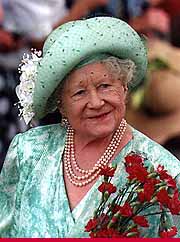HM The Queen Mother:
Indtroduction to the Queen Mother:
Lady Elizabeth Bowes-Lyon was born in 1900 at Glamis Castle, the youngest daughter of the Earl of Strathmore. She grew into a confident, charming and beautiful young woman, who came to be surrounded by a string of admirers when she was a debutante, among whom was George V's shy and diffident second son, Prince Albert, Duke of York (future King George VI). He was completely captivated by her, but thier romance was blighted by Elizabeth's reluctance to surrender her freedom. Their engagement was eventually announced in January 1923.The wedding of the Duke and Duchess of York (Albert George & Elizabeth) in April of 1923 was followed three years later by the birth of their elder daughter, Princess Elizabeth. During the 1920s, the Duchess of York injected an element of glamour into the royal family which had never been seen before or after, until advent of Princess Diana. He love and support for Prince Albert (future King George VI) gave him new confidence in carrying out his offical duties, and the Duchess herself charmed people wherever she went.
Today, at 98 years old, the Queen Mother is seen as a symbol of the grace of the monarchy and she serves as a model for future royals to come.
Elizabeth, the Queen Mother:
The woman who twice declined a prince's proposal of marriage and was reluctant to marry into the royal family because she felt she would "never again be free to think, speak or act as I really feel," has emerged as on of the most popular royals this century. To onlookers, it may seem as though Queen Elizabeth, the Queen Mother, has led a charmed life. She married the King's second son at the age of 23, had two pretty daughters and, a decade or so later, slipped effortlessly into the role of Queen. After the death of her husband she became, almost overnight, the nation's favourite grandmother. It reads like a fairytale, but few people realize that Queen Elizabeth had faced many crises in her life and has overcome them all by sheer strength of character. Part of her success is perhaps due to her avility to view the royal role in a detached manner unavailable to those born to the job.Fiercely protective of her husband, George VI, she apparently believes that his life was shortened by the stresses of the war, and was never able to forgive her brother-in-law (Edward VIII) and Mrs. Simpson who thrust the throne upon George VI. The abdication of Edward VIII dramatically changed the life of her family, and the new queen dealt with this crisis in a characteristically practical manner. She ensured that her elder daughter learnt about constitutional history and provided her husband with an outstanding and totally supportive partner. The Queen's sister commented on the royal marriage saying, "They were so particularly together. The King was a rock to her, indeed to all of us. In fundamental things she leant on him."
The public trials of the war years were succeeded by a far more personal anguish. The King, worn out by the strain of the war, was suffering from arteriosclerosis. He became subject to depression and from 1948 was in a great deal of pain. When lung cancer was diagnosed in September 1951, the Queen kept the true seriousness of the condition from her husband. The fortitude with which she coped with his illness and early death was quite remarkable, but there is no doubt about the extent of her bereavement.
Widowed at the comparatively early age of 51, she retreated from the public eye in the months following the King's death. By the summer of 1953 she seemed to have picked up the threads of her life once more, devoting herself to her family, horse racing, and the renovation of her new Scottish home, the Castle of Mey. She adored her grandchildren and it was evident that both her daughters relied on her advice. Princess Margaret, in particular, needed her mother's guidance during the 1950's. She had fallen in love with one of her father's equerries, Group Captain Peter Townsend, a divorced man 16 years her senior. With the shadow of the abdication never far away, the Queen Mother was desperately worried about the effect of such a marriage on the country, but at the same time was completely sympathetic to her daughter's plight.
The Queen Mother resumed offical duties in 1953, embarking on extensive foreign tours Rhodesia, Canada, and the USA. She continued to enjoy foreign travel until well into her eighties and has kept up a punishing round of public engagements, working at a pace that would exhaust lesser mortals. It is this devotion to duty, combined with a great natural charm, that has endeared her to people the world over. In 1980 there was a national service of thanksgiving for her eightieth birthday. The Archbishop of Canterbury seemed to sum up the Queen Mother's remarkable contribution to the nation in his address."Royalty puts a human face on the operations of government," and for over 50 years the Queen Mother has done just that. A large part of the public respect for the monarchy stems from the Queen Mother's tireless, dignified work.
by Helen Digby, "The Royal Family Album
Return to the British Royal Family Site
Return to Royal Watcher Site
Join GeoCities
